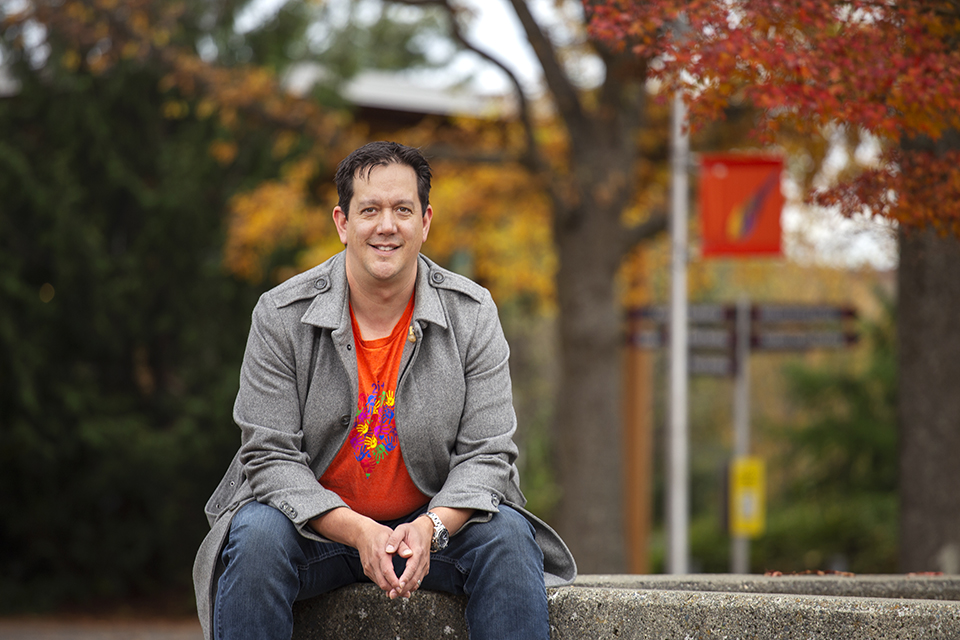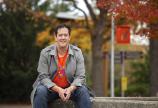Expert Q&A on the impact of Indigenous art practices on truth and reconciliation

Art not only has the power to inspire, it can also be a powerful catalyst for change. Nowhere is this more evident than in issues of truth and reconciliation, as Carey Newman (Hayalthkin’geme) well knows. Recently appointed as the inaugural Impact Chair in Indigenous Art Practices with the University of Victoria’s Faculty of Fine Arts, Newman brings his passion for decolonization and Indigenous resurgence to this new position.
A multi-disciplinary Kwakwak’awakw and Coast Salish artist, master carver, filmmaker and author, Newman strives to highlight Indigenous, social and environmental injustice through his art practice. In addressing the impacts of colonialism and capitalism, he uses material truth to unearth memory and trigger the necessary emotion to drive positive change. He is also deeply engaged with community and incorporating innovative methods derived from traditional teachings and Indigenous worldviews into his process.
Newman was most recently UVic’s sixth Audain Professor of Contemporary Art Practice of the Pacific Northwest. Now as the Impact Chair in Indigenous Art Practices, he is jointly appointed to UVic’s Department of Visual Arts and the Department of Art History and Visual Studies, where he will teach both graduate and undergraduate students, as well as continuing his own research and cultural production.
Newman is the third of four inaugural UVic Impact Chairs appointed to five-year research positions funded by the university’s strategic framework initiative. His appointment also reflects UVic’s commitment to the United Nations Sustainable Development Goals (UN SDGs), specifically the UN SDGs on reducing inequalities and on fostering peace, justice and strong institutions.
Newman discusses the intersection between his art practices and social issues, as well as his hopes to build new relationships while challenging Canada’s historical narrative.
Q. How can Indigenous art practices promote meaningful intellectual exchange and community building?
A. My artwork is inspired by, and responds to, a wide spectrum of historical and contemporary social issues. It is rooted in Kwakwaka’wakw and Sto:lo world views that see governance, law and arts as inextricably interconnected: I include all of these when considering the potential impacts of Indigenous art practices. I think about this Impact Chair position as being not just about the process and practices of Indigenous art making, but as an opportunity to discover what is possible when the distinctions between disciplines are removed, and the processes of creative production and intellectual exchange are transformed by not only changing who participates, but also the questions we pose, how we approach finding solutions and the metrics we use to evaluate success.
Q. How do you hope to use this position to build new relationships between truth, art and reconciliation?
A. When I think about the goal of reconciliation, the process begins with learning, understanding and accepting truth. I make a distinction between understanding something intellectually and feeling it on a fundamental or emotional level. I make the same distinction between being taught or told something and discovering that same thing through personal realization. That small distinction makes an enormous difference when it comes to how willing a person is to participate in, or make the sacrifices necessary for transformational change . . . like reconciliation. We know that art can be a catalyst in the process of discovering and sharing truth. We also know that art has the power to inspire people to action. This position provides me the time and resources to continue making art that addresses injustice and asks difficult questions. It also provides the opportunity to write about and critically reflect upon the process, and in doing so gain a better understanding of what works or doesn’t work and why.
Q. How can the arts help challenge the historical narrative of Canada’s colonial truth?
A. Throughout history, music, dance, literature and visual arts have all been used to confront various forms of injustice and inequality. When it comes to the genocide wrought by colonial Canada, generations of artists, scholars, activists and knowledge keepers have advocated for awareness and called for change by varying degrees of confrontation and inspiration. The work of reaching hearts and minds and then turning them to action is slow, but recently we have seen how quickly the confirmation of unmarked graves at residential schools transformed the perspective and galvanized the commitment of many in this country.
Q. How does that translate into your own art practice?
A. In my own creative practice, I build upon the work of those who came before me, making artwork that looks at how the colonial foundations of Canada have created the social, ecological, racial and economic injustices we face today. I believe that by understanding this history and recognizing how it is perpetuated today—and maybe embracing some Indigenous ways of being—we can dismantle what makes it systemic, and eventually live up to the altruistic self-image that has long been embedded in Canada’s national identity.
Q. How can this position better bridge the space between institutional and community-based learning?
A. Something that unsettles me about the way scholars and institutions engage with community-based knowledge systems is how academia views research as proprietary. Whoever publishes something gets credit and is cited as the “expert,” regardless of where the knowledge came from, or how many generations contributed to its development; even with ethics reviews and consent forms, this practice is extractive. In oral traditions, storytelling is the way knowledge is carried through generations, so it is natural to share information—but just because something is freely told, it doesn’t mean the rights to it have also been given. Better understanding this nuance between rights and responsibility will go a long way toward building stronger relationships between academia and communities.
Q. What projects are you currently working on?
A. Every project seems to take longer than expected, so they always end up overlapping, but as I begin my term as Impact Chair in Indigenous Art Practices, there are two projects that I am particularly excited about. The first is establishing the unCentre for Arts and Decolonisation, a legacy of the Witness Blanket that will take an anti-oppressive, anti-racist, nonhierarchical approach to collaboration. My goal is to encourage more interdisciplinary creative/research projects that address the root causes of systemic issues that broadly impact society, including (but not limited to) Indigenous injustice, systemic racism, gendered violence, the climate crisis and global inequality. The other one is a conceptual art project called “The Seedling” that will ask us to transform our relationship with land, reconsider who and what our governance serves, and challenge us to change our actions and sense of collective responsibility today by radically expanding the timeline we use when planning for the future.
-- 30 --
Photos
Media contacts
Carey Newman (Visual Arts/Art History & Visual Studies) at careynewman@uvic.ca
John Threlfall (Fine Arts Communications) at 250-721-6222 or johnt@uvic.ca
Tara Sharpe (University Communications + Marketing) at 250-721-6248 or tksharpe@uvic.ca

